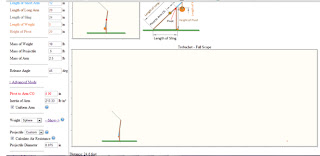History
Trebuchets were first created in China or areas
around China. The trebuchet made its way to the Byzantine Empire through the
nomadic Mongolian people called Avars. These weapons were used as both siege
and defense weapons. After the trebuchet came to Europe, the French made
certain improvements to increase range and accuracy. Apparently, trebuchets
became so reliable that they were still used after the invention of cannons.
The trebuchets are well known for being used in the medieval times to knock down
castles and fortifications.
How
It Works
A trebuchet works by using gravity and/or a heavy
load and using the force to throw a projectile a long distance. It is used like a lever, and takes advantage
of the fulcrum and the pivot point to gain energy.
Physics
Involved
The trebuchet uses gravity to launch the projectile.
The sling uses centripetal force (a= v^2/r) to gain even more distance. The
angle that the projectile is launched at will affect the outcome of the
distance. When released, the potential energy of the weight changes to kinetic
as it is affected by gravity, which in turn moves the arm and then the
potential energy of the sling changes to kinetic as well. The velocity of the
object, when graphed using x= gravity multiplied by time squared divided by 2
(x=gt^2/2) and y= velocity squared divided by gravity multiplied by 2
(y=v^2/2g), the graph will be parabolic.



























